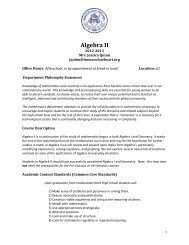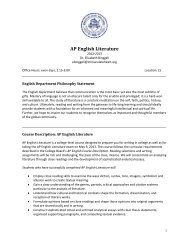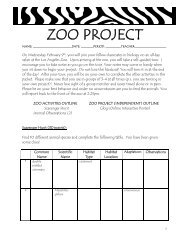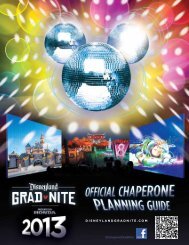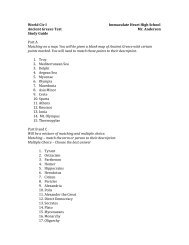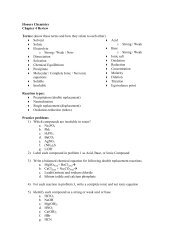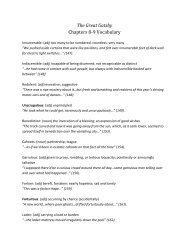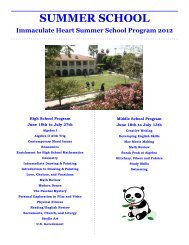Research Paper Packet and Guidelines
Research Paper Packet and Guidelines
Research Paper Packet and Guidelines
You also want an ePaper? Increase the reach of your titles
YUMPU automatically turns print PDFs into web optimized ePapers that Google loves.
<strong>Research</strong> Project<br />
Mr. Anderson<br />
AP European History IHHS 2012-13<br />
Overview<br />
This is a project that will introduce you to the various stages that are involved in<br />
the creation of a research paper. The skills that you will be developing are essential to<br />
your success in college, or other higher levels of learning.<br />
The project will culminate in a research paper, approximately 5-8 pages long. The<br />
project will be completed in manageable stages, each with a specific deadline, so that you<br />
will not be attempting to complete the project all at once.<br />
An important note: The successful completion of this project is absolutely<br />
essential to your grade in this class (Basically, it is worth A LOT of points). Noncompletion<br />
of some, if not all, of the components can result in a significantly reduced<br />
grade in the class. Overall, with all the components combined, the entire project is worth<br />
up to 250 points. This is equivalent to 2.5 exams, so it must be taken seriously.<br />
Phases of the Project<br />
1. Choosing a Topic (25 points)<br />
• Questions that you’ll want to consider when choosing a topic: What am I<br />
interested in? What do I want to learn more about? Is my topic broad<br />
enough to write an entire paper?<br />
• Select several possibilities, <strong>and</strong> then begin to look for available sources.<br />
Narrow down your choices to one topic.<br />
• Keep in mind that this paper will not be a narrative, but one in which you<br />
will be arguing a point of view – in essence, you will be presenting a<br />
thesis statement. When you think about topics, think of something about<br />
which you can make an argument.<br />
• Do not hesitate to come see me if you are having trouble choosing a topic.<br />
Requirement: Turn in your proposed topic <strong>and</strong> the possible stance you will<br />
be taking in regards to that topic. Must be typed.<br />
Due Date: Tuesday, February 5, 2013<br />
2. Annotated Bibliography <strong>and</strong> Thesis (50 points)<br />
• This will be the first part of the actual research for your paper. You will<br />
need to find 5 - 8 sources that will supply you with the material you need<br />
to write your paper.<br />
• You must have a mixture of digital <strong>and</strong> non-digital sources. However, in<br />
regards to digital (internet) sources, you are limited to three sources. The<br />
rest must be from books or articles. * I realize in the Internet age we live<br />
in there are many books online. I am going to clarify what a “digital”<br />
source is in terms of this paper; A digital source is a source that was<br />
generated for the purpose of online viewing only. For example, an article<br />
1
from CNN.com is a digital source. A scholarly journal found on JSTOR is<br />
not.<br />
• In your annotated bibliography you are required to write a paragraph<br />
summarizing the information contained in each source. (This must be in<br />
MLA format, see attached example, MLA Format for Annotated<br />
Bibliographies).<br />
• Also by this point, you will need to have developed a tentative thesis<br />
statement. For help with a thesis statement, please see me or refer to the<br />
book Writing <strong>Research</strong> <strong>Paper</strong>s: A Complete Guide (This is just a<br />
suggestion. There are a ton of these types of books out there.).<br />
Requirement: Turn your annotated bibliography, <strong>and</strong> your thesis<br />
statement. Both must be typed.<br />
Due Date: Friday, February 22, 2013.<br />
3. Source Note Cards (25 points)<br />
• For each source you are going to use, you will be making bibliography<br />
cards. On each card, you will need a descriptive heading, factual<br />
information pertinent to your paper, <strong>and</strong> the source name <strong>and</strong> page<br />
number.<br />
Requirement: Turn in all note cards.<br />
Due Date: Friday, March 8, 2013. Please note that your thesis <strong>and</strong> outline<br />
are also due on this day.<br />
4. Thesis <strong>and</strong> Outline (50 points)<br />
• Re-write your thesis, if it needs to be re-written. It may have changed<br />
since you have concluded your research. It should not change much after<br />
this point.<br />
• Type a thorough outline of the information your paper is going to cover.<br />
(See attached h<strong>and</strong>out, Structure of <strong>Paper</strong>)<br />
Requirement: Turn in your thesis statement <strong>and</strong> your outline. Both must be<br />
typed.<br />
Due Date: Friday, March 8, 2013. Please note that your source notecards<br />
are also due on this day.<br />
5. Final Draft (100 points)<br />
• Write your paper! By this point, this should be the easy part, since you<br />
have gotten the research <strong>and</strong> outline out of the way.<br />
• Use MLA format, in-text citations, <strong>and</strong> include a Works Cited page. (See<br />
attached h<strong>and</strong>outs, In-Text Citations, Works Cited Page<br />
2
Requirement: Turn in your completed paper, with separate works cited<br />
page attached. This must be typed.<br />
Due Date: Monday, April 8, 2013.<br />
3
MLA Format for Annotated Bibliographies<br />
Examples:<br />
Fryer, Sarah Beebe. "Beneath the Mask: The Plight of Daisy Buchanan."<br />
Critical Essays on F. Scott Fitzgerald's The Great Gatsby. Ed. Scott Donaldson.<br />
Boston: G.K. Hall, 1984. 153-166. This is a feminist essay that argues that Daisy<br />
is trapped in cultural constructions of Rich Wife <strong>and</strong> Pretty Girl - she chooses the<br />
"unsatisfactory stability" of her marriage because of those constructions. Fryer's<br />
only mention of Jordan is a foil to Daisy - - "Like Jordan, Daisy is affected"<br />
(156).<br />
Kerr, Frances. "Feeling Half-Feminine: Modernism <strong>and</strong> the Politics of<br />
Emotion in The Great Gatsby." American Literature 68 (1996): 405-31. A<br />
brilliant analysis of the homoerotics in the novel--Nick's attraction to McKee <strong>and</strong><br />
to Gatsby. Kerr thinks the tennis girl with sweat on her lip is Jordan (which I<br />
think is wrong); she notes that Jordan has more control over her emotions than the<br />
other women in the novel (Daisy <strong>and</strong> Myrtle). Kerr argues that Nick's narrative<br />
about his dumping her "leads the reader to believe that it is Jordan's indifference,<br />
shallowness, <strong>and</strong> dishonesty that prompt his move. The psychological subtext of<br />
Gatsby, however, suggests a motivation entirely different. Nick Carraway<br />
identifies with <strong>and</strong> feels most romantically drawn not to 'masculine' women but to<br />
'feminine' men" (418).<br />
M<strong>and</strong>el, Jerome. "The Grotesque Rose: Medieval Romance<br />
<strong>and</strong> The Great Gatsby." Modern Fiction Studies 34(1988): 541-558. M<strong>and</strong>el<br />
argues that Gatsby follows many of the conventions of medieval romance, <strong>and</strong><br />
analyzes East <strong>and</strong> West Egg as competing courts, Buchanan as a prince/Lord with<br />
Daisy as unattainable queen/fair lady. Gatsby <strong>and</strong> Nick are both construed as<br />
knights; Jordan is only mentioned in passing as a sort of attendant figure on<br />
Queen Daisy. This whole analysis seems somewhat farfetched.<br />
4
Structure of <strong>Paper</strong><br />
Mr. Anderson<br />
AP European History IHHS 2012-13<br />
The following is a rough outline of how your essay could be structured. Please<br />
note that this is only a suggestion or possible example of how the essay should be<br />
structured. If you choose to structure your essay if a different manner, that is acceptable,<br />
as long as you are meeting all the listed requirements.<br />
Again, if you are struggling with one or more of the different sections, please<br />
come see me for assistance.<br />
I. Introduction<br />
a. Brief overview of the topic of the essay<br />
b. A full explanation of your thesis, or the position you will be taking in<br />
regards to the essay topic<br />
II. Overview of the Essay Topic<br />
a. A thorough explanation of the history of your topic<br />
b. This should give the reader a complete underst<strong>and</strong>ing of the topic<br />
III. Explanation of Your Thesis<br />
a. A detailed analysis <strong>and</strong> explanation of your thesis<br />
b. Be sure to use numerous historical examples to support or defend your<br />
assertion<br />
IV. Explanation of Opposing Arguments to Your Thesis<br />
a. Detailed analysis or explanation of all or some of the opposing arguments<br />
to your thesis<br />
V. Conclusion<br />
a. Re-statement of your thesis<br />
5
MLA In-Text Parenthetical Citations<br />
The Modern Language Association (MLA) guidelines require that you cite the quotations,<br />
summaries, paraphrases, <strong>and</strong> other material used from sources within parentheses typically placed<br />
at the end of the sentence in which the quoted or paraphrased material appears. The parenthetical<br />
method replaces the use of citational footnotes. These in-text parenthetical citations correspond to<br />
the full bibliographic entries found in a list of references at the end of your paper. (Note that the<br />
titles of works are underlined rather than placed in italics.) Unless otherwise indicated, on-line<br />
sources follow the same pattern as print versions.<br />
Single author named in parentheses.<br />
The tendency to come to terms with difficult experiences is referred to as a "purification process"<br />
whereby "threatening or painful dissonances are warded off to preserve intact a clear <strong>and</strong><br />
articulated image of oneself <strong>and</strong> one’s place in the world" (Sennett 11).<br />
Single author named in a signal phrase.<br />
Social historian Richard Sennett names the tendency to come to terms with difficult experiences a<br />
"purification process" whereby "threatening or painful dissonances are warded off to preserve<br />
intact a clear <strong>and</strong> articulated image of oneself <strong>and</strong> one’s place in the world" (11).<br />
Two or more authors.<br />
Certain literacy theorists have gone so far as to declare that "the most significant elements of<br />
human culture are undoubtedly channeled through words, <strong>and</strong> reside in the particular range of<br />
meanings <strong>and</strong> attitudes which members of any society attach to their verbal symbols" (Goody <strong>and</strong><br />
Watt 323).<br />
Corporate author (organization, association, etc.).<br />
The federal government has funded research concerning consumer protection <strong>and</strong> consumer<br />
transactions with online pharmacies (Food <strong>and</strong> Drug Administration 125).<br />
Works with no author.<br />
Several critics of the concept of the transparent society ask if a large society would be able to<br />
h<strong>and</strong>le the complete loss of privacy ("Surveillance Society" 115).<br />
Two or more works by the same author.<br />
In his investigation of social identity, The Uses of Disorder, Sennett defines adulthood as a stage<br />
where people "learn to tolerate painful ambiguity <strong>and</strong> uncertainty" (108).<br />
In a surprising move, Richard Sennett combines the idea of power with that of virtue: "the idea of<br />
strength is complex in ordinary life because of what might be called the element of its integrity"<br />
(Authority 19).<br />
Work found in an anthology or edited collection.<br />
For an essay, short story, or other document included in an anthology or edited collection, use the<br />
name of the author of the work, not the editor of the anthology or collection, but use the page<br />
numbers from the anthology or collection.<br />
Lawrence Rosenfield analyzes the way in which New York’s Central Park held a socializing<br />
function for nineteenth-century residents similar to that of traditional republican civic oratory<br />
(222).<br />
6
Bible passage.<br />
Unfortunately, the president could not recall the truism that "Wisdom is a fountain to one who has<br />
it, but folly is the punishment of fools" (New Oxford Annotated Bible, Prov. 20-22).<br />
Secondary source of a quotation (someone quoted within the text of another author).<br />
As Erickson reminds us, the early psychoanalysts focused on a single objective: "introspective<br />
honesty in the service of self enlightenment" (qtd. in Weil<strong>and</strong> 42).<br />
Web page.<br />
Abraham Lincoln's birthplace was designated as a National Historical Site in 1959 (National Park<br />
Service).<br />
Note: Internet citations follow the style of printed works. Personal or corporate author <strong>and</strong> page<br />
number should be given if they exist on the website.<br />
Further information: http://library.duke.edu/research/citing/within/mla.html<br />
7
Works Cited MLA Format<br />
Book Sources<br />
First or single author's name is written last name, first name. The basic form for a book<br />
citation is:<br />
Lastname, Firstname. Title of Book. Place of Publication: Publisher, Year of Publication.<br />
Book with One Author<br />
Gleick, James. Chaos: Making a New Science. New York: Penguin Books, 1987.<br />
Henley, Patricia. The Hummingbird House. Denver: MacMurray, 1999.<br />
Book with More Than One Author<br />
First author name is written last name first; subsequent author names are written first<br />
name, last name.<br />
Gillespie, Paula, <strong>and</strong> Neal Lerner. The Allyn <strong>and</strong> Bacon Guide to Peer Tutoring. Boston:<br />
Allyn, 2000.<br />
Web Sources<br />
Web sites (in MLA style, the "W" in Web is capitalized, <strong>and</strong> "Web site" or "Web sites"<br />
are written as two words) <strong>and</strong> Web pages are arguably the most commonly cited form of<br />
electronic resource today. Below are a variety of Web sites <strong>and</strong> pages you might need to<br />
cite.<br />
An Entire Web Site<br />
Basic format:<br />
Name of Site. Date of Posting/Revision. Name of institution/organization affiliated with<br />
the site (sometimes found in copyright statements). Date you accessed the site [electronic<br />
address].<br />
It is necessary to list your date of access because web postings are often updated, <strong>and</strong><br />
information available on one date may no longer be available later. Be sure to include the<br />
complete address for the site. Here are some examples:<br />
The Purdue OWL Family of Sites. 26 Aug. 2005. The Writing Lab <strong>and</strong> OWL at Purdue<br />
<strong>and</strong> Purdue University. 23 April 2006 .<br />
Felluga, Dino. Guide to Literary <strong>and</strong> Critical Theory. 28 Nov. 2003. Purdue University.<br />
10 May 2006 .<br />
Further Information:<br />
http://owl.english.purdue.edu/owl/resource/557/06/<br />
8



